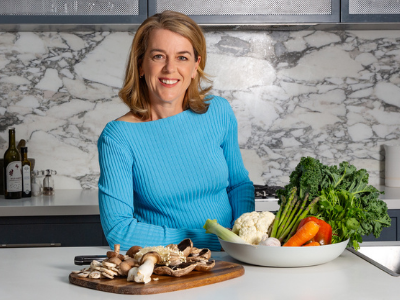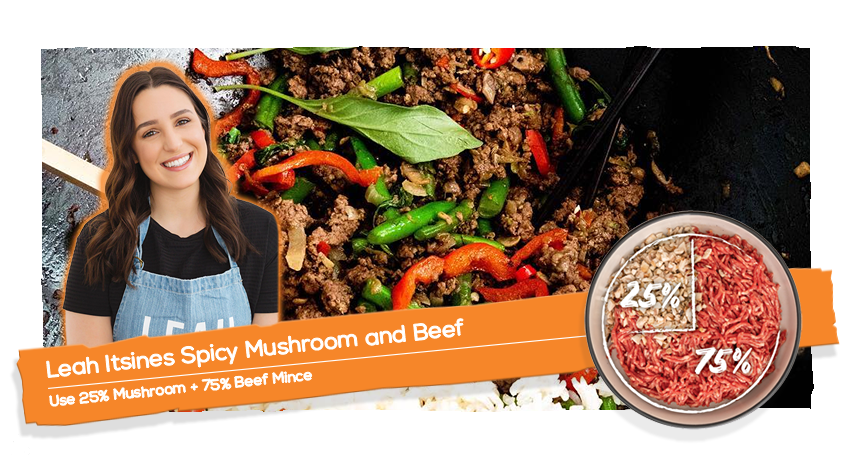
Father’s Day is a great time to remind our Dad’s, Grand Dads, husbands, partners and brother, just how much we love them and care for their health and well-being.
Mushrooms are a great food to maintain overall good health as they are nutrient rich, have low energy density, are high in bioactive compounds and have a positive immune effect. More specifically in terms of cancer prevention, mushrooms contain compounds that suppress the enzyme that is thought to play a role in the development of prostate cancer.
So not only do they taste great, but Mushrooms are also good for you too.
Here are our top five reasons why Dad should eat Mushrooms this Father’s Day
(and every other day too!)
1. Mushrooms may support Immunity
Antioxidants are natural compounds in food that help neutralise the damaging free radicals produced by the body that tend to speed up the ageing process. Mushrooms contain the strong antioxidant ergothioneine, in addition, there are many other antioxidants in mushrooms that help our immune system, like glucans and flavonoids.
Australian research shows that mushrooms have polysaccharides that seem to stop cancer cells from forming and increase immunoglobulin A levels.
2. Mushrooms may assist with the prevention of Prostate Cancer
A study published online Sept. 4, 2019, by the International Journal of Cancer (USA) showed a possible connection between regular mushroom consumption and a lower risk of prostate cancer.
The researchers recruited more than 36,000 men aged 40 to 79. They recorded various health information, such as physical activity, family and medical history, and diet. Information on diet included 39 foods and beverages. The men were then followed for a period ranging from 13 to almost 25 years.
The researchers found that men who consumed mushrooms once or twice a week — an average of about 85 grams per serving (approx. 3 mushroom cups) — had an 8% lower risk of prostate cancer compared with those who ate no mushrooms. And among men who ate mushrooms three or more times per week, risk was 17% lower. Another upside: the link held regardless of the men's intake of other vegetables and fruit or how much meat and dairy they consumed.
The findings cannot prove cause and effect, but the study's authors suggest that mushrooms' high levels of ergothioneine, an antioxidant and potential cancer preventive, may play a factor. Shiitake, oyster, maitake, and king oyster mushrooms have the highest concentrations of ergothioneine.
3. Mushrooms could reduce the risk of gout
Gout is a type of arthritis that is characterised by high levels of uric acid (hyperuricaemia) in the blood and is more likely to occur in men than women. The high levels of uric acid can trigger the disposition of sodium urate crystals in joins, causing intense joint pain.
Gout has long been associated with being overweight, binge eating and alcohol consumption. Losing weight and avoiding alcohol is common advice for many people with gout as this reduces the incidence of gout attacks.
Mushrooms are very low in kilojoules and help control appetite, making them ideal for weight control. As weight loss reduces gout attacks in overweight people, mushrooms can have an additional benefit for the gout sufferer.
4. Mushrooms help with brain health
There is a good chance you have never heard of ergothioneine. It is a very powerful antioxidant that protects our DNA and body cells. It is so important that it has its own blood transporter – it is like having your own chauffeur driven limo carrying you around the body. Low levels of ergothioneine can cause cell damage, so it has been suggested that it is acting very much like a vitamin. On the other hand, a diet rich in ergothioneine is associated with a lower risk neurological disorders and early death. Ergothioneine is found in very few fruits or vegetables, making mushrooms a very useful source for vegetarians.
5. Mushrooms can help with weight management
We know mushrooms are low in kilojoules, but another bonus that comes with adding mushrooms to your meals is that they are more filling. It is an amino acid, called glutamic acid, that is the main contributor to umami. Glutamic acid is a molecule that sends signals to the brain to regulate your appetite. Put simply, it helps you to avoid over-eating as it seems to satisfy your appetite quicker and encourage you to eat less during the day.
So, there you have it!
Mushrooms are not only a great tasting addition to the daily meal, but they are also a healthy addition for Dad’s everywhere.
Note: the information in this article is meant as general information only. For specific, personal advice on any medical condition, please see your doctor.
AMGA Dietitian - Jane Freeman
Jane is an internationally regarded and experienced dietitian and nutritionist, is an IOC (International Olympic Committee) qualified sports nutritionist, Leiths qualified cook and an award-winning author.
As a practicing dietitian and director for CANutriton, a cancer specialist nutrition practice in Sydney, Jane is big mushroom lover and passionate about delivering practical nutrition advice that is easy to understand and adopt.
References:
Mushrooms and Immune Health
Jeong SC, Koyyalamudi SR, Pang G. (2012) Dietary intake of Agaricus bisporus white button mushroom accelerates salivary immunoglobulin A secretion in healthy volunteers. Nutrition 28 (5), 527-531
Jeong SC, Koyyalamudi SR, Jeong YT, Song CH, Pang G. (2012) Macrophage immunomodulating and antitumor activities of polysaccharides isolated from Agaricus bisporus white button mushrooms. Journal of Medicinal Food 15 (1), 58-65
Pellegrini N, Serafini M, Colombi B, Del Rio D, Salvatore S, Bianchi M, Brighenti F. (2003) Total antioxidant capacity of plant foods, beverages and oils consumed in Italy assessed by three different in vitro assays. J Nutrition 133, 2812-2819
Savoie JM, Minvielle N, Largeteau ML. (2008) Radical-scavenging properties of extracts from the white button mushroom, Agaricus bisporus. Journal of the Science of Food & Agriculture 88, 970-975
Mushrooms and Prostate Cancer
Zhang, S., Sugawara, Y., Chen, S., Beelman, R.B., Tsuduki, T., Tomata, Y., Matsuyama, S. and Tsuji, I. (2020), Mushroom consumption and incident risk of prostate cancer in Japan: A pooled analysis of the Miyagi Cohort Study and the Ohsaki Cohort Study. Int. J. Cancer, 146: 2712-2720.
Mushrooms and Cognitive Health
Beelman R.B., Kalaras M.D., Phillips A.T., Richie J.P. (2020) Is ergothioneine a ‘longevity vitamin’ limited in the American diet? Journal of Nutritional Science 9, e52 doi:10.1017/jns.2020.44
Gründemann D. (2012) The erogothioneine transporter controls and indicates ergothioneine activity – a review. Preventive Medicine 54, S71-S74
Halliwell B., Cheah I.K., Drum C.L. (2016) Ergothioneine, an adaptive antioxidant for the protection of injured tissues? A hypothesis. Biochemical and Biophysical Research Communications 470, 245-250
Paul BD, Snyder SH. (2010) The unusual amino acid L-ergothioneine is a physiologic cytoprotectant. Cell Death & Differentiation 17, 1134-1140
Weigand-Heller AJ, Kris-Etherton PM, Beelman RB. (2012) The bioavailability or ergothioneine from mushrooms (Agaricus bisporus) and the acute effects on antioxidant capacity and biomarkers of inflammation. Preventive Medicine 54 (suppl), S75-S78
Mushrooms and Gout
Choi HK, Curhan G 2004. Beer, liquor, and wine consumption and serum uric acid level: the Third National Health and Nutrition Examination Survey. Arthritis Care Research; 51: 1023-1029
Choi HK 2010. A prescription for lifestyle change in patients with hyperuricemia and gout. Current Opinion in Rheumatology; 22: 165-172
Chuang SY, Lee SC, Hsieh YT, Pan WH 2011. Trends in hyperuricemia and gout prevalence: Nutrition and Health Survey in Taiwan from 1993-1996 to 2005-2008. Asia Pacific Journal of Clinical Nutrition; 29 (2): 301-308
Fam AG 2005. Gout: excess calories, purines, and alcohol intake and beyond. Response to a urate-lowering diet. Journal of Rheumatology; 32 (5): 773-777
Mushrooms for weight management
Mouritsen OG (2012). Umami flavour as a means of regulating food intake and improving nutrition and health. Nutrition & Health 21 (1), 56-75 |
Myrdal Miller A, Mills K, Wong T, Dresher G, Lee SM, Sirimuangmoon C, Schaefer S, Langstaff S, Minor B and Guinard JX. (2014) “Flavor-enhancing properties of mushrooms in meat-based dishes in which sodium has been reduced and meat has been partially substituted with mushrooms.” Journal of Food Science. 79(9), S1795-804. doi: 10.1111/1750-3841.12549
Magarowski G., Giacona G., Patriarca L., Papadopoulos K., Garza-Naveda P., Radziejowska J., Alonso-Alonso M. (2018) Neurocognitive effects of umami: association with eating behavior and food choice. Neuropsychopharmacology 43: 2009-2016
Wong K.M., Corradini M.G., Autio W., Kinchla A.J. (2018) Sodium reduction strategies through use of meat extenders (white button mushrooms vs. textured soy) in beef patties. Food Science and Nutrition 7, 506-518
Join our Mushroom Lovers Club!
Receive delicious Mushroom recipies and much more.




